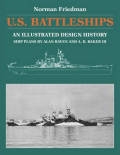This book covers the development of U.S. battleships, from the Maine and Texas of 1886, through the Montana class of World War II, up to the recommissioned Iowas. It examines the original designs as well as the many modifications and reconstructions these ships underwent during their long and active careers. Like the other books in Norman Friedman’s design-history series, U.S. Battleships is based largely on formerly classified internal U.S. Navy records. But research for this book has also included a full survey of British files, both those compiled when American ships served with the Royal Navy in the two world wars and those supplied by British battleship designers attached to the U.S. Navy. In addition, the author consulted official battle damage reports to help evaluate various designs.
Friedman, a leading authority of U.S. warships, explains the political and technical rationales for building battleships and recounts the evolution of each design. He shows clearly how battleship development reflects the interplay between police postures and technological capabilities, for perhaps more than any other category of warships in the pre-World War II American navy, the battleship was subject to political forces. Theodore Roosevelt’s desire for a “big stick” to enforce his foreign policy, for example, gave rise to his Great White Fleet of 1907-09, the United States’s first battle fleet. Franklin Roosevelt’s fear of being branded as a militarist, on the other hand, constrained U.S. battleship construction and armament in the late 1930s.
Battleship designs proposed but not built are described in detail. They include, among others, the pre-cursor of the Maine; a torpedo battleship of 1912; the “Tillman battleship” of 1916; a 66,000-ton “maximum battleship” of 1934; and the Montana of World War II. Freidman analyzes whether the design was a serious project or simply a ploy to test relations with foreign powers. A final chapter reveals the many abortive postwar projects for battleship conversion and shows the extensive modifications the New Jersey that were made in 1981-82. Friedman also indicates what future improvements may be in store for U.S. battleships.
Appendixes include a full description of the first modern armored ship, the civil War monitor, and an account of the damage to U.S. battleships at Pearl Harbor.
Alan Raven and A.D. Baker III have drawn detailed scale outboard and plan views of the each battleship class and of major modifications to many classes. The author has provided inboard profiles and sketches of abortive projects. Numerous photographs, many of them never before published, complement the text.
Naval historians and architects alike will find U.S. Battleships to be the most comprehensive reference available on the subject. Battleships buffs, long enamored of this, the most elegant and glamorous of warships, will find the author’s treatment of its development a fitting tribute to its decades of service to the U.S. Navy.
